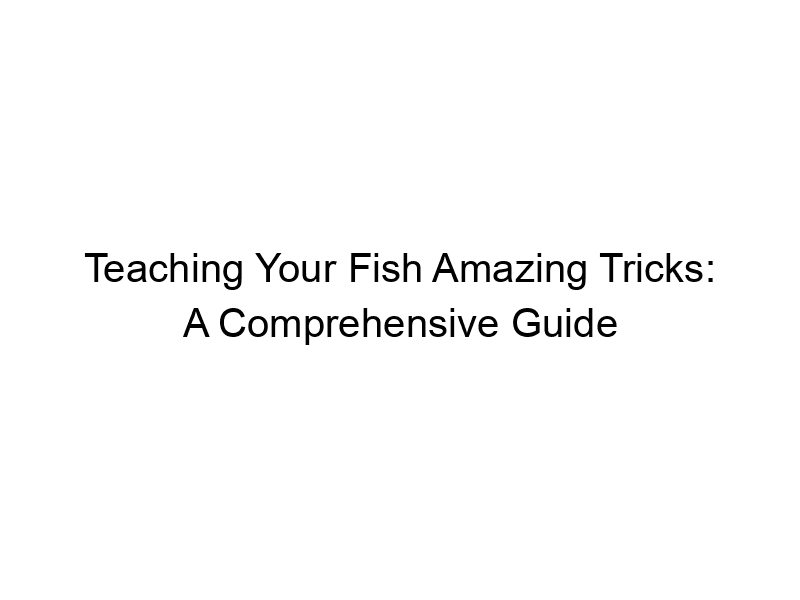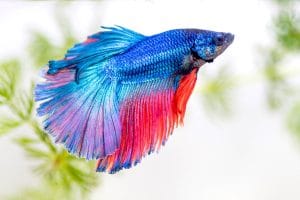Have you ever wondered if your fish understands you? More than just pretty decorations for your aquarium, fish are surprisingly intelligent creatures capable of learning complex behaviors. This guide delves into the fascinating world of How to Train Your Fish: Fun Tricks to Try, exploring various techniques, common challenges, and rewarding experiences you can share with your finned friends. We’ll cover everything from basic conditioning to advanced trick training, ensuring you have the knowledge and confidence to build a stronger bond with your aquatic pets. You’ll learn how to select the right fish, design effective training programs, and troubleshoot common issues along the way.
Before embarking on any training program, it’s crucial to understand your fish’s species-specific behaviors and temperament. Different fish species exhibit varying levels of intelligence and trainability. For
example, goldfish are known for their learning capabilities, while some more passive species may require more patience and tailored approaches. Observe their daily routines, feeding patterns, and responses to stimuli to gain insights into their individual personalities and preferences. This foundational understanding will pave the way for successful training.
Classical Conditioning and Operant Conditioning
Fish training primarily relies on two fundamental learning principles: classical conditioning and operant conditioning. Classical conditioning involves associating a neutral stimulus (e.g., a tap on the glass) with a naturally occurring stimulus (e.g., feeding time). Eventually, the neutral stimulus alone will elicit the same response as the natural stimulus – your fish will anticipate food whenever you tap on the glass. Operant conditioning, on the other hand, uses reinforcement (positive or negative) to strengthen desired behaviors. Rewarding desired actions (positive reinforcement) with food or other desirable stimuli will encourage their repetition.
Choosing the Right Fish for Training
Species Suitable for Training
Goldfish, bettas, and some species of cichlids are often considered good candidates for training due to their intelligence and responsiveness to stimuli. Goldfish, in particular, are known for their ability to learn tricks and recognize their owners. Bettas, though sometimes perceived as aggressive, can be trained with patience and understanding, focusing on rewarding calm and cooperative behavior. Research the specific needs and temperament of your chosen species before starting.
Assessing Your Fish’s Individual Personality
Even within a species, individual fish exhibit varying degrees of trainability. Some fish are naturally more curious and eager to please, while others are more timid or independent. Observing your fish’s behavior will help you tailor your training approach. Some fish might respond better to visual cues, while others may be more sensitive to auditory cues.
Developing a Training Program
Setting Realistic Goals and Expectations
Begin with simple tricks and gradually increase the complexity as your fish progresses. Don’t expect immediate results; training takes time, patience, and consistency. Start with short, frequent training sessions to avoid overwhelming your fish. Celebrate small victories to build their confidence and your own motivation.
Choosing Effective Rewards
Your fish’s favorite food is the most powerful reward. This might be a specific type of flake food, a live food item, or a small portion of specially prepared treats. Introduce the reward only during training sessions to maintain its value. Ensure the reward is appropriate for your fish species and size, avoiding anything that could compromise their health.
Training Techniques and Tricks
Target Training: The Foundation of Fish Training
Target training involves teaching your fish to touch a specific object (the target) using a food reward. Start with a simple target, such as a small stick or a brightly colored object, and move it gently towards your fish. When the fish touches the target, immediately reward them. Consistently repeating this process will eventually train your fish to actively seek out the target.
Teaching Your Fish to Jump
This visually striking trick involves coaxing your fish to jump out of the water (a short distance) to grab a treat. It’s crucial to ensure the fish doesn’t injure itself. Start by dangling a tempting treat near the water’s surface. As the fish gets closer, gradually raise the treat slightly higher, rewarding successful jumps.
Other Fun Tricks: Swimming Through Hoops, Following a Laser Pointer
Once your fish masters target training, you can progress to more complex tricks. A simple hoop can be made from plastic tubing, and slowly guiding your fish through it with the target will teach them this entertaining feat. A low-power laser pointer can also be used to direct your fish’s movements, rewarding their pursuit of the “light bug.” Always ensure the laser doesn’t directly touch the fish’s eyes.
Maintaining Consistency and Addressing Challenges
The Importance of Regular Training Sessions
Consistency is key to success in fish training. Aim for short, frequent sessions (2-3 times a day) rather than long, infrequent ones. Regular training reinforces learned behaviors and strengthens the bond between you and your fish. If you miss a few days, your fish might require more time to relearn a trick.
Troubleshooting Common Training Problems
If your fish isn’t responding as expected, re-evaluate your training approach. The reward might be insufficiently appealing, the training sessions might be too long or too infrequent, or the fish might be distracted or unwell. Observe your fish’s behavior and adjust your technique accordingly. Sometimes a break is necessary before restarting the training process.
Advanced Training Techniques and Considerations
Using Visual Cues and Hand Signals
Once your fish reliably responds to a specific target, you can begin to introduce hand signals or other visual cues. This allows you to eventually phase out the physical target, increasing the complexity and entertainment value of the interaction. Pair the hand signals consistently with the target and reward until your fish understands the new cue.
Introducing Multiple Tricks and Sequences
Once your fish masters a few basic tricks, you can start to combine them into sequences or teach entirely new maneuvers. Be patient and break down complex tricks into smaller, manageable steps, rewarding each individual component of the sequence.
Understanding the Limits of Fish Intelligence
While fish are capable of learning impressive tricks, it’s important to acknowledge their cognitive limitations. They are not capable of complex problem-solving or abstract reasoning in the same way as mammals. Be realistic with your expectations and enjoy the unique bond you are building with your aquatic companion.
The Benefits of Training Your Fish
Enrichment and Stimulation
Fish training provides mental and environmental enrichment for your fish. It challenges their cognitive abilities, preventing boredom and promoting a more engaging environment within the aquarium. A stimulated fish will be healthier and more vibrant.
Strengthening the Human-Animal Bond
The process of training your fish fosters a unique connection between you and your pet. It allows you to observe their behaviors closely, appreciate their individuality, and engage with them on a deeper level.
Limitations of Fish Training
Species-Specific Trainability
Not all fish are equally trainable. Some species are naturally more receptive to training than others, influenced by their inherent intelligence, temperament, and visual acuity.
Time and Patience Required
Fish training requires patience and consistency. It’s not a quick process, and results won’t be immediate. Be prepared to dedicate time and effort to see your fish learn and improve.
Comparing Different Training Methods
Positive vs. Negative Reinforcement
Positive reinforcement, which involves rewarding desired behaviors, is always the preferred method. Negative reinforcement, which involves removing an aversive stimulus, should be avoided as it can cause stress and fear in your fish.
Visual vs. Auditory Cues
Different fish may respond better to visual or auditory cues. Observe your fish’s reactions to different stimuli and adjust your training approach accordingly.
Individual vs. Group Training
Individual training allows you to focus on your fish’s specific needs and learning style. Group training can be more challenging but can also be engaging and fun if all the fish involved are receptive.
Setting Up Your Training Environment
Maintaining a Calm and Peaceful Aquarium
Ensure your aquarium is clean, well-maintained, and free from stressors. A clean and stable environment creates a calm atmosphere, optimal for your fish to focus and learn.
Minimizing Distractions During Training
Reduce distractions during training sessions by dimming the lights, reducing noise levels, and limiting visual clutter around the aquarium. The less distraction, the more focused your fish will be on the training task.
Frequently Asked Questions
What are the best types of fish for training?
Goldfish, bettas, and certain cichlids are known for their trainability. However, individual personalities within each species will vary.
How long does it take to train a fish?
Training times vary significantly depending on the fish, the complexity of the trick, and the trainer’s consistency. It can take weeks or even months to master certain tricks.
What if my fish isn’t learning?
Re-evaluate your training approach. Are you using effective rewards? Are the training sessions too long or infrequent? Is your fish stressed or unwell? Adjust your strategy and consider taking a break before trying again.
Can I train multiple fish at once?
It’s possible, but it is more challenging and requires more patience. Focus on individual recognition and reward to avoid confusion.
Are there any dangers associated with fish training?
Yes, ensure all treats are fish-safe. Jumping tricks must be performed safely, avoiding injury. Avoid stressing your fish through overly demanding sessions.
What are some creative tricks I can teach my fish?
Besides jumping and swimming through hoops, you can teach your fish to follow a laser pointer, approach a specific spot on the tank glass, or even differentiate between colors.
How often should I train my fish?
Short, frequent sessions (2-3 times daily) of 5-10 minutes are more effective than lengthy, infrequent ones.
Can I use treats other than fish food?
While fish food is the most reliable and natural reward, you could experiment with small, safe bits of vegetables, but always prioritize their nutritional needs.
Final Thoughts
Training your fish is a rewarding and enriching experience. It fosters a deeper connection with your aquatic companions, providing mental stimulation for them and offering a unique, engaging hobby for you. While it requires patience and consistency, the satisfaction of seeing your fish learn and perform tricks is unparalleled. Remember to choose the right fish, develop a clear and consistent training program, and always prioritize your fish’s well-being. Start with simple tricks and gradually progress to more challenging ones. Celebrate your successes, and don’t be discouraged by setbacks. With dedication and the right approach, you’ll be amazed by what your fish can learn! So, start observing your fish, gather your rewards, and embark on this exciting journey of aquatic companionship!




